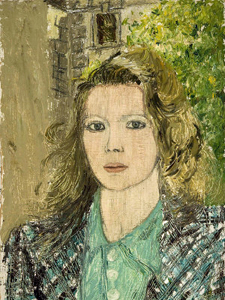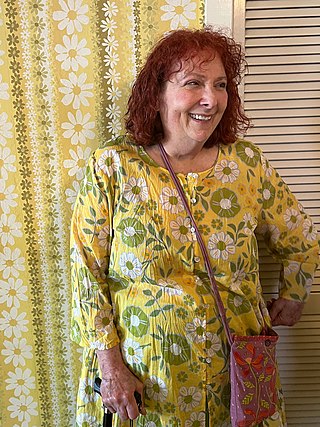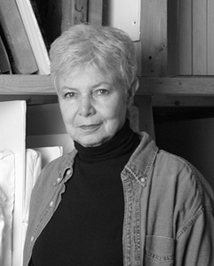Related Research Articles

Judy Chicago is an American feminist artist, art educator, and writer known for her large collaborative art installation pieces about birth and creation images, which examine the role of women in history and culture. During the 1970s, Chicago founded the first feminist art program in the United States at California State University, Fresno which acted as a catalyst for feminist art and art education during the 1970s. Her inclusion in hundreds of publications in various areas of the world showcases her influence in the worldwide art community. Additionally, many of her books have been published in other countries, making her work more accessible to international readers. Chicago's work incorporates a variety of artistic skills, such as needlework, counterbalanced with skills such as welding and pyrotechnics. Chicago's most well known work is The Dinner Party, which is permanently installed in the Elizabeth A. Sackler Center for Feminist Art at the Brooklyn Museum. The Dinner Party celebrates the accomplishments of women throughout history and is widely regarded as the first epic feminist artwork. Other notable art projects by Chicago include International Honor Quilt, Birth Project, Powerplay, and The Holocaust Project. She is represented by Jessica Silverman gallery.

Louise Nevelson was an American sculptor known for her monumental, monochromatic, wooden wall pieces and outdoor sculptures. Born in the Poltava Governorate of the Russian Empire, she emigrated with her family to the United States in the early 20th century. Nevelson learned English at school, as she spoke Yiddish at home.
Ana Mendieta was a Cuban-American performance artist, sculptor, painter, and video artist who is best known for her "earth-body" artwork. She is considered one of the most influential Cuban-American artists of the post–World War II era. Born in Havana, Cuba, Mendieta left for the United States in 1961.

Monica Sjöö was a Swedish-born British-based painter, writer and radical anarcho/ eco-feminist who was an early exponent of the Goddess movement. Her books and paintings were foundational to the development of feminist art in Britain, beginning at the time of the founding of the women's liberation movement around 1970.

Shigeko Kubota was a Japanese video artist, sculptor and avant-garde performance artist, who mostly lived in New York City. She was one of the first artists to adopt the portable video camera Sony Portapak in 1970, likening it to a "new paintbrush." Kubota is known for constructing sculptural installations with a strong DIY aesthetic, which include sculptures with embedded monitors playing her original videos. She was a key member and influence on Fluxus, the international group of avant-garde artists centered on George Maciunas, having been involved with the group since witnessing John Cage perform in Tokyo in 1962 and subsequently moving to New York in 1964. She was closely associated with George Brecht, Jackson Mac Low, John Cage, Joe Jones, Nam June Paik, and Ay-O, among other members of Fluxus. Kubota was deemed "Vice Chairman" of the Fluxus Organization by Maciunas.
Wangechi Mutu is a Kenyan American visual artist, known primarily for her painting, sculpture, film, and performance work. Born in Kenya, Mutu now splits her time between her studio there in Nairobi and her studio in Brooklyn, New York, where she has lived and worked for over 20 years. Mutu's work has directed the female body as subject through collage painting, immersive installation, and live and video performance while exploring questions of self-image, gender constructs, cultural trauma, and environmental destruction and notions of beauty and power.

Hannah Wilke (born Arlene Hannah Butter; was an American painter, sculptor, photographer, video artist and performance artist. Wilke's work is known for exploring issues of feminism, sexuality and femininity.

Linda Nochlin was an American art historian, Lila Acheson Wallace Professor Emerita of Modern Art at New York University Institute of Fine Arts, and writer. As a prominent feminist art historian, she became well known for her pioneering 1971 article "Why Have There Been No Great Women Artists?" published by ARTnews.

A.I.R. Gallery is the first all female artists cooperative gallery in the United States. It was founded in 1972 with the objective of providing a professional and permanent exhibition space for women artists during a time in which the works shown at commercial galleries in New York City were almost exclusively by male artists. A.I.R. is a not-for-profit, self-underwritten arts organization, with a board of directors made up of its New York based artists. The gallery was originally located in SoHo at 97 Wooster Street, and was located on 111 Front Street in the DUMBO neighborhood of Brooklyn until 2015. In May 2015, A.I.R. Gallery moved to its current location at 155 Plymouth St, Brooklyn, NY 11201.

The feminist art movement in the United States began in the early 1970s and sought to promote the study, creation, understanding and promotion of women's art. First-generation feminist artists include Judy Chicago, Miriam Schapiro, Suzanne Lacy, Judith Bernstein, Sheila de Bretteville, Mary Beth Edelson, Carolee Schneeman, Rachel Rosenthal, and many other women. They were part of the Feminist art movement in the United States in the early 1970s to develop feminist writing and art. The movement spread quickly through museum protests in both New York and Los Angeles, via an early network called W.E.B. that disseminated news of feminist art activities from 1971 to 1973 in a nationally circulated newsletter, and at conferences such as the West Coast Women's Artists Conference held at California Institute of the Arts and the Conference of Women in the Visual Arts, at the Corcoran School of Art in Washington, D.C..

Sylvia Sleigh was a Welsh-born naturalised American realist painter who lived and worked in New York City. She is known for her role in the feminist art movement and especially for reversing traditional gender roles in her paintings of nude men, often using conventional female poses from historical paintings by male artists like Diego Vélazquez, Titian, and Jean-Auguste-Dominique Ingres. Her most well-known subjects were art critics, feminist artists, and her husband, Lawrence Alloway.
Harmony Hammond is an American artist, activist, curator, and writer. She was a prominent figure in the founding of the feminist art movement in 1970s New York.
Nancy Grossman is an American artist. Grossman is best known for her wood and leather sculptures of heads.

Nancy Buchanan is a Los Angeles-based artist best known for her work in installation, performance, and video art. She played a central role in the feminist art movement in Los Angeles in the 1970s. Her work has been exhibited widely and is collected by major museums including the Museum of Modern Art and the Centre Pompidou.
Mary Beth Edelson was an American artist and pioneer of the feminist art movement, deemed one of the notable "first-generation feminist artists". Edelson was a printmaker, book artist, collage artist, painter, photographer, performance artist, and author. Her works have been shown at the Museum of Modern Art, the Smithsonian American Art Museum, and the Museum of Contemporary Art in Chicago.
New York Feminist Art Institute (NYFAI) was founded in 1979 by women artists, educators and professionals. NYFAI offered workshops and classes, held performances and exhibitions and special events that contributed to the political and cultural import of the women's movement at the time. The women's art school focused on self-development and discovery as well as art. Nancy Azara introduced "visual diaries" to artists to draw and paint images that arose from consciousness-raising classes and their personal lives. In the first half of the 1980s the school was named the Women's Center for Learning and it expanded its artistic and academic programs. Ceres Gallery was opened in 1985 after the school moved to TriBeCa and, like the school, it catered to women artists. NYFAI participated in protests to increase women's art shown at the Museum of Modern Art, The Whitney Museum of American Art and other museums. It held exhibitions and workshops and provided rental and studio space for women artists. Unable to secure sufficient funding to continue its operations, NYFAI closed in 1990. Ceres Gallery moved to SoHo and then to Chelsea and remained a gallery for women's art. However, a group continues to meet called (RE)PRESENT, a series of intergenerational dialogues at a NYC gallery to encourage discussion across generations about contemporary issues for women in the arts. It is open to all.
Irene Peslikis was an American feminist artist, activist, and educator. She was one of the early founders and organizers in the women's art movement, especially on the east coast.

Nancy Youdelman is a mixed media sculptor who lives and works in Clovis, California. She also taught art at California State University, Fresno from 1999 until her retirement in 2013. "Since the early 1970s Youdelman has been transforming clothing into sculpture, combining women's and girl's dresses, hats, gloves, shoes, and undergarments with a variety of organic materials and common household objects.
Elizabeth Erickson is an American painter, feminist artist, poet, and educator. Her style of painting tends to gestural abstraction and the themes she explores occupy "the territories of ancient myth, religion, and spiritual feminism," according to art historian Joanna Inglot.

Merle Temkin is a New York City-based painter, sculptor and installation artist, known for vibrant, abstracted paintings based on her own enlarged fingerprint, and earlier site-specific, mirrored installations of the 1980s. Her work has often involved knitting-like processes of assemblage and re-assemblage, visual fragmentation and dislocation, and explorations of identity, the hand and body, and gender. In addition, critics have remarked on the play in her work between systematic experimentation and intuitive exploration. Her painted and sewn "Fingerprints" body of work has been noted for its "handmade" quality and "sheer formal beauty" in the Chicago Sun-Times and described elsewhere as an "intensely focused," obsessive joining of thread and paint with "the directness and desperation of marks on cave walls." Critic Dominique Nahas wrote "Temkin's labor-intensive cartography sutures the map of autobiography onto that of the universal in sharply revelatory ways." Her public sculptures have been recognized for their unexpected perceptual effects and encouragement of viewer participation. Temkin's work has been featured in publications including the New York Times, Artforum, ARTnews, New York Magazine, and the Washington Post. Her work belongs to the permanent collections of the Racine Art Museum, Museum of Arts and Design in New York, and Israel Museum, among others.
References
- ↑ Owens, Georgette L. (1997). International Women Artists - Entering The Second Millenium. Greenbrae (CA): Alliance of Women Artists. pp. 14–5 (192pp.). ISBN 0-9658412-0-0.
- ↑ Heresies
- ↑ "Nancy Azara". National Women's History Museum. Retrieved January 11, 2020.
- ↑ ASSESSING AN INFLUENTIAL ART SCHOOL FOR WOMEN - PANEL DISCUSSION, "THE NY FEMINIST ART INSTITUTE: PROGRAMS AND LEGACY"; THURS. NOV. 19TH, 4:00 PM." US Fed News Service, Including US State News
- ↑ "Athens Cultural Center".
- ↑ "On Knowing Unknowing: A Material Narrative".
- ↑ https://www.sitebrooklyn.com/exhibitions-2 [ dead link ]
- ↑ "Labyrinths of the Minds - Dialogue and Opening Reception (2019-05-18)".
- ↑ "Meeting of the Birds".
- ↑ "Ink: New Prints".
- ↑ Nancy Azara, Spirit Taking Form: Making a Spiritual Practice of Making Art. (York Beach, Maine: Red Wheel/Weiser, LLC: 2002)
- ↑ REPRESENT
- ↑ Nancy Azara and Darla Bjork, "Our Journey to the New York Feminist Art Institute", Entering the Picture: Judy Chicago, the Fresno Feminist Art Program and the Collective Visions of Women Artists, ed: Jill Fields, PhD, (Routledge, 2011)
- ↑ "In Pursuit of the Divine", The Kensington and Winchester Papers: Painting, Sculpture and the Spiritual Dimension, (Oneiros Books, 2003)
- ↑ Nancy Azara and Darla Bjork "Our Journey to the New York Feminist Art Institute", From Our Voices, ed. Laurel Lampela and Ed Chuck, (Kendall/Hunt Publications: 2003)
- ↑ "Spirit Taking Form: Making a Spiritual Practice of Making Art", (Red Wheel/Weiser, LLC:2002)
- ↑ "The Language of Art is Still Defined by Men"
- ↑ "Spirit Taking Form: Making a Spiritual Practice of Making Art" in 2002
- ↑ Nancy Azara, Re-Visioning catalogue, Maitland Art Center, Florida, July 2005.
- ↑ Azara, Nancy. "Orange Branch with Gold / Tree Altar / Circle with Seven Hands / Great Coat." Frontiers, vol. 21, no. 3, 2000
- ↑ Azara, Nancy. "Orange Branch with Gold / Tree Altar / Circle with Seven Hands / Great Coat." Frontiers
- ↑ http://www.nancyazara.com/collages.html, "Crow Sandal"